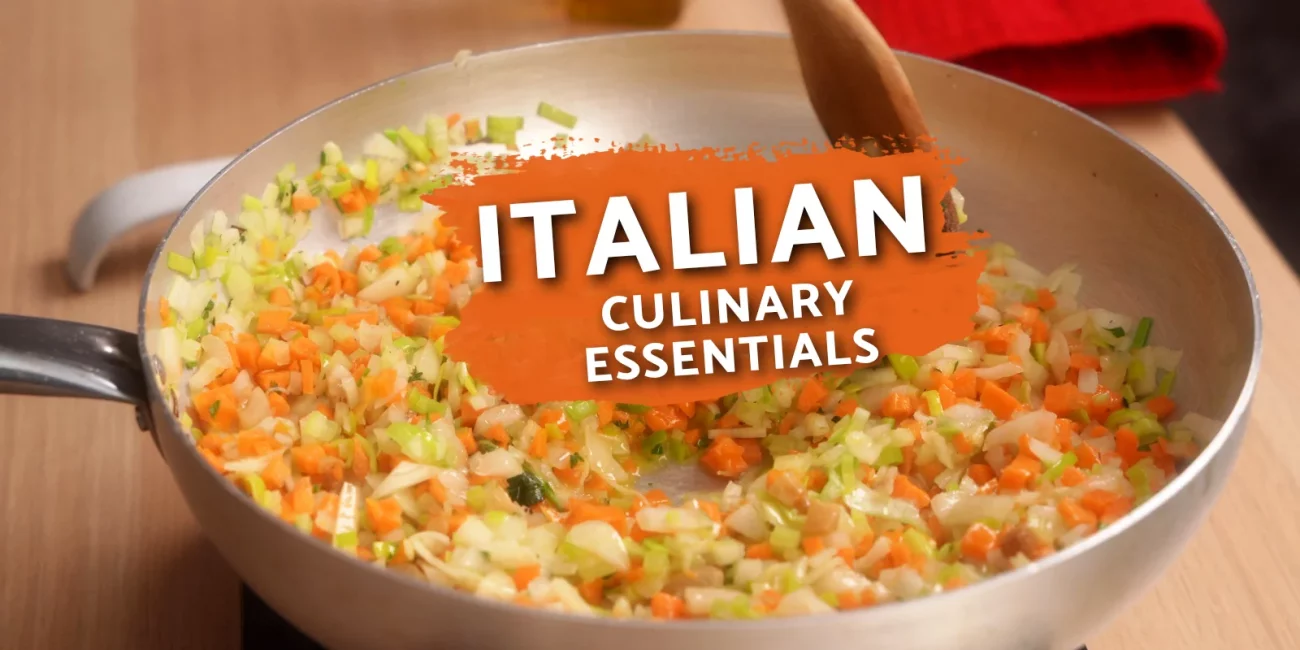(Italian Cooking Vocabulary from Authentic Sources)
If you’re diving into our Free Online Italian Cooking Classes, you’ll notice we use terms that come straight from Italian kitchens and culinary schools—not just English cooking shortcuts.
From mantecatura to q.b., these are the real techniques and phrases used by professional chefs and seasoned home cooks across Italy. Understanding them will not only deepen your skills but also give you a more intuitive grasp of what Italian cooking is all about.
Mantecatura: The Final Creaming Technique
- Mantecatura (from mantecare, meaning “to cream or blend”) is the final stage of many risotti and pasta dishes, where the sauce and starch-rich pasta water are vigorously stirred—often off heat—with fats like cheese, butter, or olive oil to create a glossy, cohesive sauce.
It’s the technique that gives Carbonara or Cacio e Pepe that beautiful, velvety texture without cream. The trick is timing and temperature: if the pan is too hot, the cheese will clump. The Mantecatura is often done off the heat when cheese is involved to avoid mistakes. We walk you through this in detail in our Pasta Courses.

Soffritto
In Italian cooking, soffritto refers to the gentle sautéing of aromatics in oil or fat to form the flavor base of a dish. Soffritto is not strictly limited to onion, carrot, and celery. That trio (called a soffritto classico or soffritto alla bolognese) is just the most common version in many Italian regions, especially for ragù and vegetable soups.
However, in broader usage — both historically and in modern Italian kitchens — “soffritto” simply refers to any aromatic base gently sautéed in fat to start a dish. That can include:
- Garlic
- Onion (alone or with garlic)
- Carrot and celery (with or without onion)
- Chili pepper
- Rosemary, sage, or bay leaf
- Pancetta, guanciale, or lardo (in fat-forward soffritti)
- Even anchovies in oil
Many regional recipes call this soffriggere gli odori — sautéing aromatics — and the mix depends entirely on the dish and the region.

Q.B. (Quanto Basta)
This abbreviation stands for quanto basta, meaning “as much as needed.” You’ll see it in Italian recipes next to ingredients like salt, pepper, or olive oil.
Rather than providing exact measurements, q.b. encourages you to cook by feel—taste, adjust, and develop instinct for balance. You will especially find this term used liberally in older Italian recipes and cookbooks.
Bagnomaria
This is the Italian term for a water bath, or what English-speaking cooks know as a double boiler. It’s used to gently melt chocolate, heat sauces without curdling, or keep dishes warm without direct heat. It’s also used to gently cook egg sauce to safe temperatures for dishes like Spaghetti alla Carbonara.
You’ll also see bagnomaria used in dessert preparation, especially with custards or zabaglione.

Al Dente
Al dente translates as “to the tooth.” It refers to cooking pasta until it has a firm bite—not mushy, not underdone. Every quality pasta product should have an al dente cooking time recommendation on the package.
Cooking pasta al dente is essential for both texture and sauce absorption. It also helps prevent overcooking during mantecatura, when the pasta is tossed with sauce in a hot pan.
Etto / Eti
In Italian cooking, an etto refers to 100 grams. It’s a common unit in older cookbooks and in daily speech across Italy. Instead of saying “100 grams of pasta,” an Italian recipe might say “1 etto di pasta.” Two etti (plural) would be 200 grams, and so on.
This casual unit is still used frequently in traditional recipes, especially when portions are flexible or approximate.
Why Bronze-Die Pasta Matters
Bronze-die pasta is extruded through rough bronze molds, giving it a textured surface that holds sauce much better than smooth, industrial pasta.
Italians favor bronze-die cut pasta for almost every dish where dry pasta is used, from Pasta Amatriciana to Spaghetti with Clam Sauce. That texture is what allows sauces to cling properly and deliver flavor in every bite. Check out our article to learn about Best Pasta Brands available in Italy and abroad!
How Italians Prepare Tomatoes
Unless using very thin-skinned cherry tomatoes, Italian cooks typically blanch tomatoes to remove the skin. The process is simple: score the tomato, boil it for 30 seconds, then peel.
They also discard seeds and excess liquid, which can add unwanted acidity and dilute the sauce’s flavor.
Instead of using pre-crushed tomatoes (which often include skins and seeds), they start with passata or whole peeled tomatoes, then blend or crush them after removing what doesn’t belong. This preserves sweetness and texture. Check out our guide to Best Canned Tomatoes for Sauce and more.
Aged vs Semi-Aged Pecorino
Aged Pecorino Romano has an intense, salty flavor but doesn’t melt easily. That can lead to clumps in emulsified sauces like Carbonara or Cacio e Pepe.
Semi-aged pecorino offers a good balance: it melts more smoothly but still adds flavor. That’s why Italian chefs often recommend using semi-aged pecorino—or a mix—for creamy pasta dishes.
Learn These Terms in Context
We use all of these techniques and terms in our Free Online Italian Cooking Classes for Pasta. Each course page includes:
- A 4K video with multiple subtitle languages
- Detailed step-by-step instructions
- Ingredient tips and cultural context
- Equipment suggestions and traditional techniques
This vocabulary isn’t just for reading—it’s part of how we teach you to cook like Italians do.
